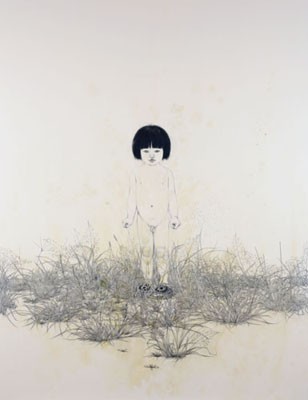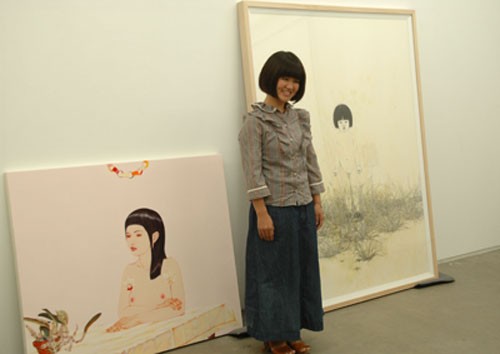(click here for the previous interview)
A world and a prayer at the same time

Hare 2011 water color, pencil on paper mounted on wood panel 180 x 140 cm
ⓒMasako Ando Courtesy of Tomio Koyama Gallery
Tsubouchi:
I now want to turn to the motifs in your works. Of all the things that interest you, why do you choose to paint children (or what appears to be children), insects and plants? Also, can you talk about the vague sense of depth that I noticed in your backgrounds?
Ando:
Perhaps I can say the image borrows its shape from the human figure?
It is like a child standing with such and such an expression, in such and such a location.
There is an aspect like that of a natural phenomenon, like a human giving birth to another human.
It’s like this from the beginning, so it cannot be separated even if you try to cut it.
If there is a human, then there exists a place, and at that place other creatures exist as well. All things come with the other.
Human are able to express feelings through facial expressions and hand gestures, and it might be easier to empathize with other people than with animals and plants. You can express much more complicated things with human motifs. You can express even more with the figure of a child.
People are more accepting of a child as a motif.
A face with wrinkles, on the other hand, is a much stronger element, so if I’m going to include such a face, it will have had to come to me from the very beginning. I wonder if I might paint such a face when my own has become wrinkled.
When I am drawing, I sometimes feel as if I were making something like a Buddhist statue or temple. I can only call the picture a “world” and a prayer at the same time, but it also assumes something similar to those in form.
The child in the center is something like Sakyamuni or Bodhisattva, the grass at his feet is his flanking attendants, and the insects, flowers and rocks around him are like the four heavenly kings, eight legions, twelve divine generals and ten great disciples.
Even if it isn’t that clear what surrounds a Bodhisattva or Amitabha, a Japanese would intuitively know there would be a couple of Nio figures (Deva kings) at the gate of a temple, a main Buddha at the center of the temple, a small-size Buddha or human figures representing those beings of the Buddhist world, and some plants and animals. Also, that the landscape in the background would not be real and the characters would all be on pedestals.
In my paintings, the flowers and plants seem to take the form of pedestals. Furthermore, figures of the Buddha from ancient times must have been created to express images and prayer by borrowing from the human figure.
A Trinity of Image, Spirit and Words
Tsubouchi:
Perhaps you are like the sculptor who carves wood to reveal the Buddha that resides within. The way you paint while listening to the loud voice of the picture seems to overlap with how Enku, the Buddhist sculptor of the Edo period, used to work.
By the way, when you first started to attract attention, your works were described as “paintings that tell a story.” Regardless of whether the phrase “tell a story” describes your pictures precisely or not, your titles, some of which are quotes from novels, seem to be saying a lot (laughs). Can you tell us how you title your works and what role titles serve?
Ando:
For me, the title is exactly the same as the image and motif. Words are one of the members that sit at the table from the very start, sipping tea (laughs). The images in my pictures are contiguous with my life; there is no starting or finishing point.
Titles are both a part and the whole at the same time. It is like a trinity consisting of image, spirit and word. I think the idea of a trinity might be the most natural explanation. At any rate, the title is very important.
Words and motifs arise and disappear within my conscious and unconscious on a daily basis. My own words, as well as the words that I quote, seem to be sinking into the same river bed.
Some titles are assemblages of words that have combined in a hazy fashion inside of my brain, while others consist of one specific word. Kai no Hi (fire of the seashell) is taken from Kenji Miyazawa, while Like a fiend hid in a cloud is quoted from Kenzaburo Oe’s novel. Some titles come from songs, such as Where Have All the Flowers Gone? and Zawawa. It’s like diving into the water in search of a small, shining stone, an important stone that once existed there, but which I had almost forgotten. I search for words by going back to the novel, the song or the dictionary.
I consider whether the title is abstract and concrete, in the same way as the painting.
I consider various things about the title: Is there a good balance between the image or technique and the meaning of the words or their sounds. Is it simple? Does it say too much? Most of the time I settled on the first thing that came to me.
Sometimes, I think a picture can exist without a title since it is perceived by the eye. But in the same way that giving a child a name or calling it by that name everyday acts to form the character of that child, so does the title of a picture. So perhaps it is an essential element in the picture’s realization.
Pictures are truly wondrous things
Tsubouchi:
Lastly, there is something I’ve wanted to ask you for a long time. You always call your works “pictures,” not “paintings”. Why is that?
Ando:
I call them “pictures” because it is easier to say, and I think the word suits them.
Calling them “paintings” is rather snobbish, I think (laughs). But I use the word “picture” to refer to my works, as well as those done by Picasso or by children.
But no matter how you refer to them, pictures are really wondrous to me. They are almost like a god. A picture, even if drawn well, sometimes does not impress us at all. A deformed image sometimes becomes admired throughout the world. An image, even if reproduced exactly from real life or a photograph, sometimes does not work as a picture. With my passion ignited, with one eye on reality and the other on the image, I approach my goal a little at a time, certain that between the acts of nature and the acts of humans lies a picture.
Masako Ando
Born in 1976 in Aichi prefecture, Ando received a BA (1999) and MFA (2001) from the Aichi Prefectural University of Fine Arts and Music. She had her first solo exhibition at Tomio Koyama Gallery in 2004. In 2009, she was invited to participate in the group exhibition Little Playground – Hitsuda Nobuya and His Students at the Aichi Prefectural Museum of Art and Nagoya City Art Museum. She currently lives and works in Nagoya. http://www.tomiokoyamagallery.com/artists/ando

at Tomio Koyama Gallery
————————————————-
Hara Museum of Contemporary Art
Hara Documents 9: Masako Ando – The Garden of Belly Button
July 12 (Thursday) – August 19 (Sunday), 2012
